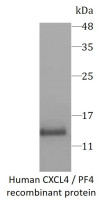ARG70425
Human CXCL4 / PF4 recombinant protein (Active) (His-tagged, N-ter)
Human CXCL4 / PF4 recombinant protein (Active) (His-tagged, N-ter) for SDS-PAGE
Overview
| Product Description | E. coli expressed, His-tagged (N-ter) Active Human PF4 recombinant protein |
|---|---|
| Tested Application | SDS-PAGE |
| Target Name | CXCL4 / PF4 |
| Species | Human |
| A.A. Sequence | Glu32 - Ser101 |
| Expression System | E. coli |
| Protein Full Name | Platelet factor 4 |
| Activity | Active |
| Activity Note | Determined by its ability to inhibit human FGF-2-induce proliferation in HUVEC cells. The ED50 for this effect is < 5 μg/mL. |
| Alternate Names | PF4; Platelet Factor 4; SCYB4; CXCL4; Chemokine (C-X-C Motif) Ligand 4; C-X-C Motif Chemokine 4; Oncostatin-A; Iroplact; PF-4 |
Properties
| Form | Powder |
|---|---|
| Purification Note | Endotoxin level is less than 0.1 EU/µg of the protein, as determined by the LAL test. |
| Purity | > 98% (by SDS-PAGE) |
| Buffer | PBS (pH 7.4) |
| Reconstitution | It is recommended to reconstitute the lyophilized protein in sterile water to a concentration not less than 200 μg/mL and incubate the stock solution for at least 20 min at room temperature to make sure the protein is dissolved completely. |
| Storage Instruction | For long term, lyophilized protein should be stored at -20°C or -80°C. After reconstitution, aliquot and store at -20°C or -80°C for up to one month. Storage in frost free freezers is not recommended. Avoid repeated freeze/thaw cycles. Suggest spin the vial prior to opening. |
| Note | For laboratory research only, not for drug, diagnostic or other use. |
Bioinformation
| Gene Symbol | PF4 |
|---|---|
| Gene Full Name | Platelet Factor 4 |
| Background | This gene encodes a member of the CXC chemokine family. This chemokine is released from the alpha granules of activated platelets in the form of a homotetramer which has high affinity for heparin and is involved in platelet aggregation. This protein is chemotactic for numerous other cell type and also functions as an inhibitor of hematopoiesis, angiogenesis and T-cell function. The protein also exhibits antimicrobial activity against Plasmodium falciparum. |
| Function | Released during platelet aggregation. Neutralizes the anticoagulant effect of heparin because it binds more strongly to heparin than to the chondroitin-4-sulfate chains of the carrier molecule. Chemotactic for neutrophils and monocytes. Inhibits endothelial cell proliferation, the short form is a more potent inhibitor than the longer form. |
| Cellular Localization | Secreted |
| PTM | Disulfide bond, Phosphoprotein |
Images (1) Click the Picture to Zoom In






